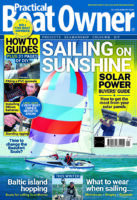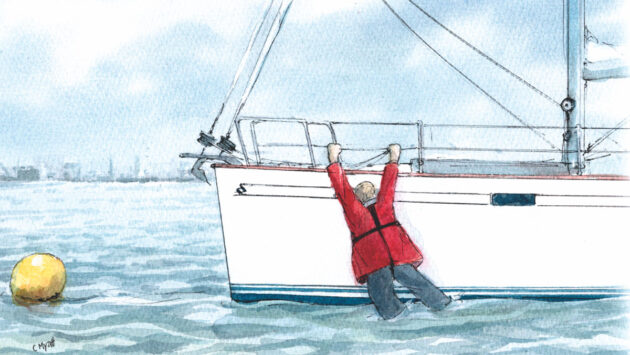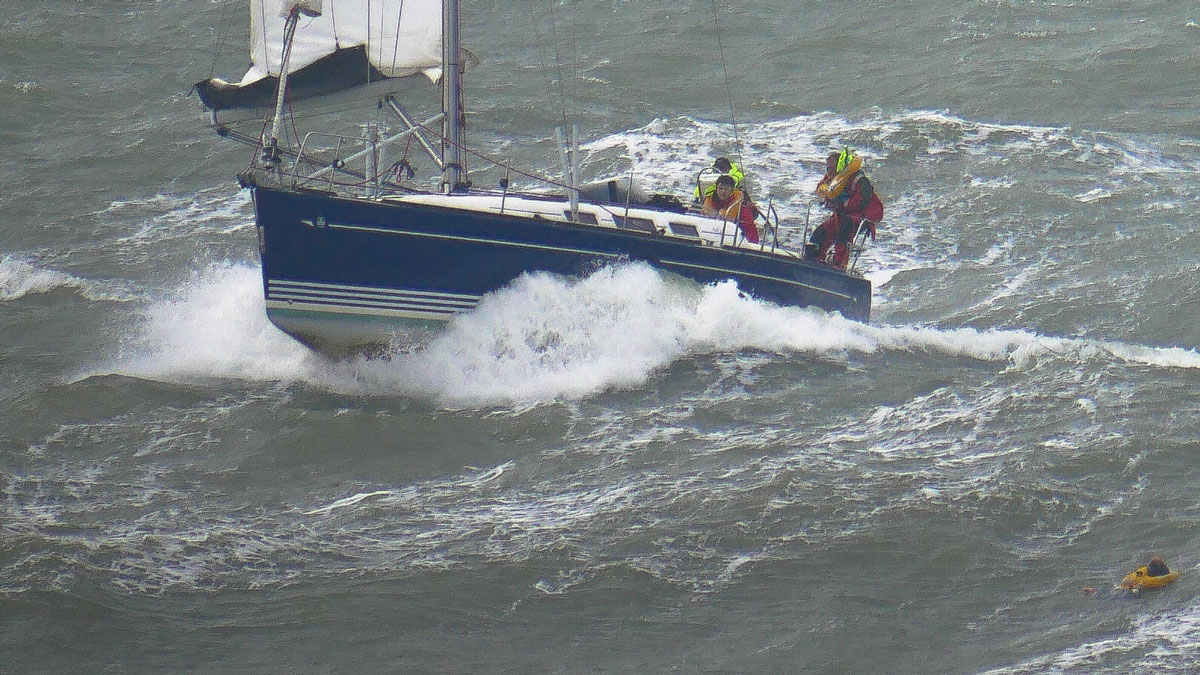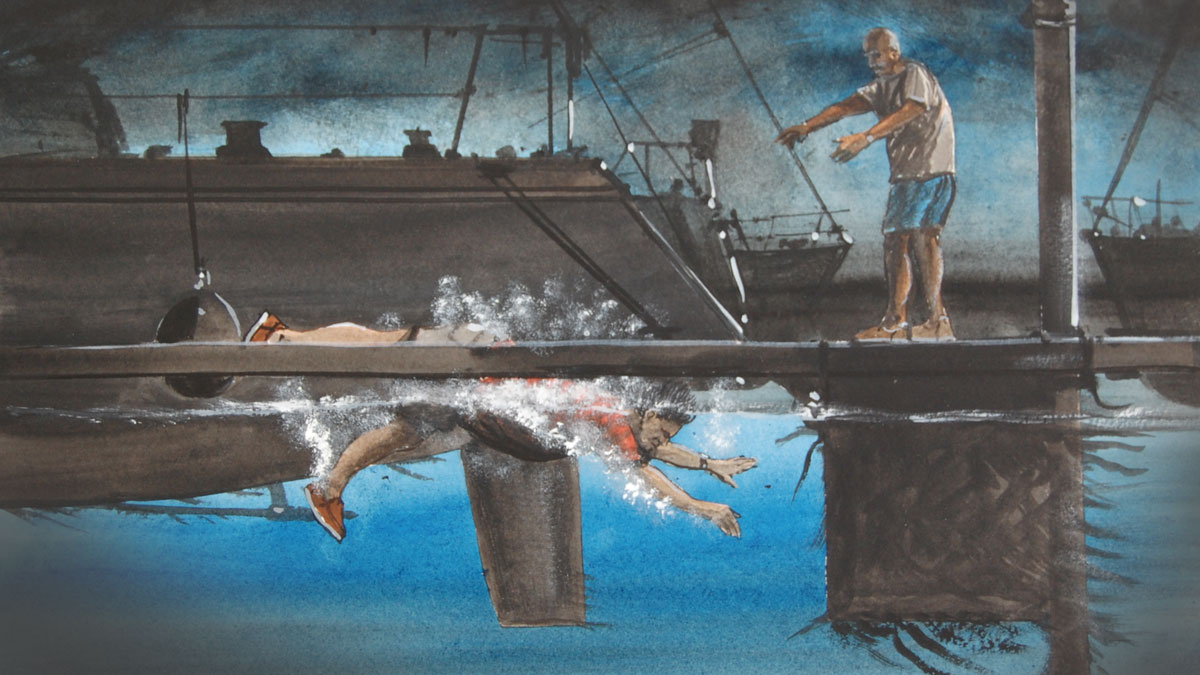Solo sailor Tony Purcell discovered how quickly a tricky situation can develop when he fell overboard his 42ft yacht on a busy tidal river
Since retiring a couple of years ago, I have been sailing around the UK, writes Tony Purcell
Mainly, they’re day sails, leaving the boat in places, going back to it and carrying on. I’m trying to visit all the beautiful ports around the coast, and am having a great time. I’ve got a 42ft boat, which is about as big as you want to sail single-handed.
A good friend of mine often sails with me, but on this particular leg, I was single-handed.
It was the end of August, I’d been enjoying the Irish coast that summer and had left the boat in Fleetwood a couple of weeks earlier.
So I returned to Fleetwood Marina on 30 August and set sail at about 0930 the following morning, bound for Liverpool, 50 miles away.
It was a beautiful day, the wind was Force 3 to 4, off the land as well, leading to a flat sea. I made good progress and got to the end of the Mersey at 1900.
I dropped my sails, as usually, this area is busy with shipping, but actually it was very quiet that Sunday evening.

Triple D on a mooring buoy – as Tony has done countless times on his round-Britain voyage. Credit: Tony Purcell
I cruised upriver under motor slowly because I had time to lose. Liverpool Marina is in the old Brunswick Dock, and there’s a lock, so you need a couple of metres over the bar before you can go in.
Based on the timetables for that day, high water was about 2200, so I wouldn’t be able to get in till 2045 at the earliest.
It was now 1930, so I thought, I’ll grab a mooring buoy for an hour or so. I wanted to watch the America’s Cup on YouTube.
There are very few places to moor up the Mersey, but I found some small craft moorings, with a huge round buoy without a pick-up line.
It was at least 750mm across, with a big, round body. The tactic I normally use for a temporary stop is to throw a large bowline over it, which should drop over the top of the buoy and hook underneath it.
Then, because it’s a very large bowline, you can pull it out of the water, get to the knot and release it.
It’s something I’ve done many, many times before.

Aerial view of Liverpool waterside area fronting on to the River Mersey. Credit: A.P.S. (UK)/Alamy
I dropped the loop over the large buoy, but it snagged on top rather than sliding over the sides of the buoy. Then, in a flash, I was hanging onto the lifelines on the wrong side of the boat. I don’t remember slipping.
I must have just leant too far and gone over. My automatic reaction must have been to grab anything.
I couldn’t lift myself onto the boat, and I couldn’t hang there for long, so I thought, “I’m going to have to drop into the water and sort things out from there.”
As soon as I did, my lifejacket inflated.
It was fairly shocking because, one minute ago, I was having a normal day – now I was in a place I didn’t want to be.
It was August, so the water temperature was fine. Fortunately, it was calm weather and everything was quite serene. I was quite a long way from the shore and couldn’t see anyone around, but I have since found out that someone with great eyesight or binoculars had spotted my tumble and called 999, I’m very grateful.
I was still holding on to the rope, which I had been trying to drop over the buoy, and I wasn’t going to let go of it.
I was effectively attached to the yacht, which was floating free. The chart predicted the tide to be running at 2-3 knots, but it was less by the mooring; otherwise, I may have had the engine in tickover to keep the boat stationary whilst I dropped the line over the buoy.
Having the engine in gear would have been very challenging once I was over the side. As it was, the engine was in neutral, so we were just at the mercy of the Mersey.
I found out later that the boat drifted about half a mile, according to my track. We drifted into the centre of the channel, but fortunately, no big ships were bearing down on us. However, it was not a good position to be in.
I am always sensible – I thought! – I kept a VHF radio in my chest pocket, but now that the lifejacket was inflated, it was totally inaccessible.
I realised it was going to take a while to get myself out of the water, so I activated my personal locator beacon (PLB), attached to my lifejacket: You pull the aerial out, lift a flap, press the red button, and that sends an alert, via satellites.
All the man overboard rescue advice says it’s best to alert the emergency services early. It was time to use this device, and I’m pleased I did.

Merseyside Fire and Rescue patrol boat at Pier Head, Liverpool. Credit: Dave Booth/Alamy
I thought about getting around the back of the boat to the swimming ladder, but that would have required letting go of the rope, and I quite fancied keeping hold of the boat.
Also, I keep my dinghy tied to the stern when sailing and, in hindsight, it does restrict access to the swim ladder.
There was another slight complication; the PLB tethered to my lifejacket had entangled around the rope, attaching me to the boat. So I was effectively tied to the rope.
Another thing that I’ve learned from this event is to always carry a knife.
I’m not sure how long the emergency services took to respond; it felt like about 15 minutes.
A rigid inflatable boat (RIB) turned up, which I thought would be the RNLI, but it was the fire service with three burly guys on board.
They threw me a line, which I grabbed, and they pulled it in and hoisted me on the dinghy.
Another thing that comes home to you after an event like this is the effort it takes to pull somebody out of the water. I’m not a particularly big guy, I weigh 70-80kg, and it took three strong crew to drag me out of the water onto the boat. Anyway, they managed it.
I was in shock from the event and starting to feel cold. They were keen to get me to the shore and off to hospital.

Triple D, Tony Purcell’s Southerly 42 at anchor in the Outer Hebrides – his favourite place so far on his round-Britain adventure. Credit: Tony Purcell
But there was a boat floating free in the Mersey, which needed making safe, plus, it contained my dry, clean clothes, and I could make myself a nice hot cup of tea. So I suggested they get me back on the boat so I could get warm and get things back under control.
I was surprised when they agreed, it seemed to suit both parties.
Back on board, I discovered that once a lifejacket has gone off, it’s really hard to take off. I was bruised, either from going over the side or being dragged into the RIB, and I needed help from the fire crew. I was soon in clean, dry clothes, with a hot cup of tea, and fortunately, I had spare lifejackets on the boat, so on with a new one.
The RNLI crew from New Brighton then turned up in their larger RIB, but it was still an hour and a half before the lock gate would open, so they hung around with me, talking and checking that I was compos mentis because I was shaken up.
Falling in is something I’ve never done in 50 years of sailing, and don’t intend to do again. In a flash, I was in quite a difficult situation.
It was probably just over-familiarity, having sailed the boat some 4,000 miles around the UK. I just don’t know how I ended up over the side.
I’m taking a lot more care now.
Once the lock gates opened, I continued on alone because they couldn’t follow me through.
The Wirral Coastguard Rescue Team was waiting to take my lines in the marina. So I was served by three of the rescue services. They were all brilliant. Having someone to assist at the marina was helpful because I wasn’t performing my best in terms of boat handling skills. I was shaken up.
Once moored up, one of the coastguard officers, who is also a first responder, checked my oxygen levels and pulse etc. He gave me the all clear, and they left me to it.
But that wasn’t the end of it in terms of the effect. The paramedic had warned me about secondary drowning, which is when fluids can build up three or four hours after you’ve been immersed.
I’d not really come across this before. I had a painful, difficult night in bed, my breathing was gurgly. The next day, after a good shower, I felt a lot better and able to continue my trip, so I sailed on to meet a friend at Conway.

Tony at the helm of Triple D
Three days later, I developed back pain, which turned out to be the onset of pneumonia. I was groggy for several days until I got to the doctor and got some antibiotics.
In hindsight, maybe a trip to the hospital at the time could have been worthwhile, as staff might have said, ‘you’ve been in the Mersey, here are some antibiotics just in case’.
It was quite a thing to get back on the boat the next day and but the advice is always to get back in the saddle and all that. I’m just more cautious about leaning too far over when mooring up.
Triple D was originally based in Cardiff, but one of the things I wanted to do before I settled on a home port was to sail around the British Isles, which has really lovely, challenging waters.
I sailed the South and East coasts in 2021, the Orkneys and Shetland in 2022, the Outer Hebrides in 2023 and Ireland and the West coast in 2024.
The highlight so far has been the Outer Hebrides, it was just gorgeous with stunning scenery and lots of little bays you can go into, and I was very fortunate, the weather was super.
My boat is now in Dartmouth, so this spring I might explore around the Isles of Scilly, and then head to the Channel Islands of Jersey and Guernsey, before doing the Round the Island Race around the Isle of Wight. I wish I’d done this voyage 10 years ago.
Rescue timing
HM Coastguard (HMCG) oversaw this incident on 31 August 2024
- 6.38pm – HMCG receives a 999 call from a member of the public who saw Tony’s fall.
- 6.40pm – New Brighton lifeboat tasked.
- 6.42pm – Wirral and Crosby Coastguard Rescue Teams alerted.
- 6.48pm – Tony’s PLB alert is activated.
- 6.50pm – Mersey Fire Service Marine Fire 1 (MERF1) team respond.
- 6.51pm – Tony is pulled out of the water and onto MERF1 rigid inflatable boat.
- 7.01pm – Tony is back on his vessel.
- 7.26pm – The RNLI lifeboat helm reports concern for Tony following his ingestion of water.
- 7.37pm – Tony’s PLB issues another distress alert – HMCG requests that MERF1 ask Tony to deactivate.
- 8.09pm – Coastguard Rescue Officers (CROs) meet with Tony aboard Triple D, medical checks are carried out. One of the CROs working on the Rescue Team is a paramedic.
- 8.41pm – the Coastguard rescue team is released from the scene.
Lessons learned from going overboard
- PLBs are essential – Everyone should have one. Invest in a PLB and emergency position-indicating radio beacon (EPIRB) for your vessel and register them with the MCA. Mine was the Ocean Signal PLB, which cost about £300-350, I’ve just contacted them again and it’s going to cost about £200 for a new battery.
- Keep equipment in pockets that are accessible even when your lifejacket expands.
- Always carry a sharp knife to cut away tangled rope or material, in a pocket that is accessible.
- Keep your handheld VHF radio where you can get at it – beware that a chest pocket can become inaccessible when a lifejacket inflates.
- Secondary drowning is a real risk – after the paramedic mentioned it, I looked in my onboard first aid manual, and there was nothing at all about it. I looked it up on the internet, and there was information there, but many people don’t seem to know about it. It’s never come up on any of the first aid courses I’ve done.
- Wear a lifejacket. I was wearing a Seago self-inflating lifejacket. I’ve replaced the cartridge on it, so it’s back to normal now, although it could do with a service.
- Keep a spare lifejacket on board.
Expert response

Michael Buratti, Coastal Operations Area Commander for HM Coastguard
Michael Buratti, Coastal Operations Area Commander for HM Coastguard, comments:
Tony was unlucky to end up in the water, and it could easily have turned into a tragedy. But this incident ended well because he did everything right – he had the appropriate equipment and knowledge to increase his safety.
Thankfully, in this case, assets were able to respond rapidly to Tony’s distress signal, and a call to HM Coastguard was made by a member of the public via 999.
Tony’s PLB activated at 6.48pm, and by 6.51pm, he was pulled aboard a Fire Service Rescue vessel. The RNLI also responded with a lifeboat, and Coastguard Rescue Officers were sent to meet Tony to assess the injuries he’d reported.
Inhalation of water can be very serious and, in rare cases, could result in secondary drowning – a medical condition which can restrict airways and cause a shock reaction where casualties can deteriorate rapidly.
HM Coastguard’s Network Commander recorded that Tony’s PLB distress call meant that even if he hadn’t been seen by a caller onshore, the Coastguard would have been alerted to his predicament due to his foresight in both carrying a PLB and wearing a lifejacket.
I’d recommend that all those aboard watercraft invest in a high-quality and well-serviced lifejacket and an effective PLB device that can rapidly alert us to a dangerous situation on the water.
Tony’s swift rescue was due in no small part to the relatively simple preparations he’d made before even setting off.
Find more information at: hmcoastguard.uk/onboard
Left for dead after falling overboard: how one sailor survived 5 hours lost at sea before rescue
Roger Cottle was presumed dead after falling overboard a 27ft yacht and lost at sea for five-and-a-half hours in a…
“It was like doing a MOB recovery wearing a neck brace” – says Round the Island Race 2024 man overboard skipper
As if this year’s Round the Island Race wasn’t tough enough for competitors with winds gusting 45mph and a rough…
New AIS MOB device rule affecting sailors
Big changes to marine radio device rules are planned to be brought into the UK. The only MOB AIS devices…
Beware becoming a man overboard (MOB)… in a marina
Everyone thinks about man overboard (MOB), but what do you do when you have a MIM, man in marina? Mark…
Want to read more articles like this?

A subscription to Practical Boat Owner magazine costs around 40% less than the cover price.
Print and digital editions are available through Magazines Direct – where you can also find the latest deals.
PBO is packed with information to help you get the most from boat ownership – whether sail or power.
-
-
-
- Take your DIY skills to the next level with trusted advice on boat maintenance and repairs
- Impartial, in-depth gear reviews
- Practical cruising tips for making the most of your time afloat
-
-
Follow us on Facebook, Instagram, TikTok and Twitter








